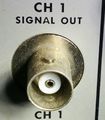BNC connector: Difference between revisions
No edit summary |
No edit summary |
||
| Line 7: | Line 7: | ||
Tektronix gear transitioned from [[UHF connector]]s to BNC connectors in | Tektronix gear transitioned from [[UHF connector]]s to BNC connectors in | ||
the early to mid-1960's. For some pieces of equipment, a conversion kit was | the early to mid-1960's. For some pieces of equipment, a conversion kit was | ||
available. | available. [[Media:Service_Scope_23_Dec_1963.pdf|Service Scope Number 23]] explains: | ||
<blockquote> | |||
Recently, Tektronix, Inc. made the decision to convert all Tektronix instruments having UHF connectors to BNC connectors and, also, that Tektronix instruments of future design will employ BNC connectors. | |||
The decision to convert the Tektronix product line to BNC connectors was based on the following facts: | |||
# BNC connectors offer lower input capacitance - an extremely important consideration in some applications. | |||
# BNC connectors have the requirements demanded by high-frequency instruments for good performance. | |||
# BNC connectors require less panel space and provide more finger room. Growing panel-density problems dictate their use. | |||
# BNC connectors are employed by the majority of manufacturers producing instruments used in conjunction with oscilloscopes. | |||
# BNC connectors are quicker and easier to connect and disconnect. | |||
</blockquote> | |||
==Links== | ==Links== | ||
Revision as of 17:14, 15 October 2024

BNC (from Bayonet Neill–Concelman, sometimes erroneously referred to as the Bayonet Naval Connector or the Baby N Connector) is the most common coaxial connector standard for measurement equipment up to 1 GHz.
It was patented in 1951 by Hazeltine Research, Inc. It is available in different impedances, but 50 Ω is, by far, the most common.
Tektronix gear transitioned from UHF connectors to BNC connectors in the early to mid-1960's. For some pieces of equipment, a conversion kit was available. Service Scope Number 23 explains:
Recently, Tektronix, Inc. made the decision to convert all Tektronix instruments having UHF connectors to BNC connectors and, also, that Tektronix instruments of future design will employ BNC connectors. The decision to convert the Tektronix product line to BNC connectors was based on the following facts:
- BNC connectors offer lower input capacitance - an extremely important consideration in some applications.
- BNC connectors have the requirements demanded by high-frequency instruments for good performance.
- BNC connectors require less panel space and provide more finger room. Growing panel-density problems dictate their use.
- BNC connectors are employed by the majority of manufacturers producing instruments used in conjunction with oscilloscopes.
- BNC connectors are quicker and easier to connect and disconnect.
Links
Pictures
-
BNC Female
-
BNC Male

